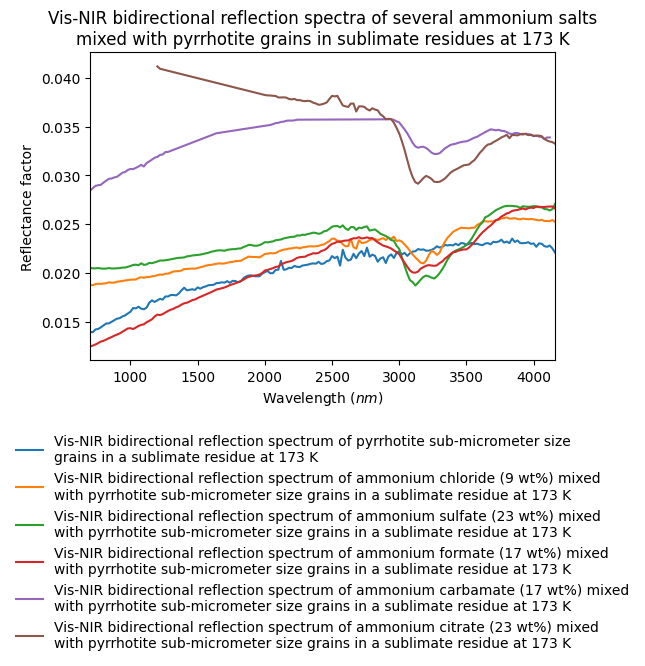- Title
- Vis-NIR bidirectional reflection spectra of several ammonium salts mixed with pyrrhotite grains in sublimate residues at 173 K
- DOI
- 10.26302/SSHADE/EXPERIMENT_OP_20191119_001
- Data reference
- Poch, Olivier; Istiqomah, Istiqomah (2018): Vis-NIR bidirectional reflection spectra of several ammonium salts mixed with pyrrhotite grains in sublimate residues at 173 K. SSHADE/GhoSST (OSUG Data Center). Dataset/Spectral Data. https://doi.org/10.26302/SSHADE/EXPERIMENT_OP_20191119_001
- Publications
- Database(s)
- Experimentalists
- Type(s)
- laboratory measurement
- Description
- Dry mixtures (called "sublimate residues") of sub-micrometer size opaque pyrrhotite (Fe1-xS) grains with ammonium (NH4+) salts (chloride, sulfate, formate, carbamate, citrate) were prepared by sublimation of ice-dust mixtures. Reflectance spectra (from 0.4 to 4 µm) of these mixtures were measured at 173 K under high vacuum (pressure lower than 10^-5 mbar).
- Number of spectra
- 8
- Variable type(s)
-
- sample composition
- sample abundance
- constituent
- Comments
- Several sublimate residues were produced in different experiments, with various type and relative concentration of ammonium salts compared to pyrrhotite.
- Instrument
- SHINE Spectro-Gonio bidirectional reflection Vis-NIR
- Sample holder
- Aluminum sample holder, cylindrical 48 mm diameter and 5 mm depth closed by a sapphire window and cooled by a He cryostat in a vacuum chamber (Carbo-NIR)
- Standard medium
- vacuum
- Observation mode
- spectrum
- Spectral range type(s)
- Vis, NIR
- Valid spectral range(s)
-
Min - Max ($nm$) Sampling ($nm$) Resolution ($nm$) Position accuracy ($nm$) Absorption edge #1 700.0 - 1380.0 20.0 10.0 #2 1400.0 - 2980.0 20.0 19.0 #3 3000.0 - 4160.0 20.0 39.0 - Filters
-
Type Center/Edge ($nm$) Width ($nm$) Place #1 long-pass filters of the spectro-gonio radiometer
Definition: incidence and emergence angles are positive with origin at nadir, and vary in same direction. Azimuth origin (increasing clockwise) is for i = e (opposition geometry).
- Observation geometry
- bidirectional
- Observation mode
- fixed angles
- Incidence angle
- 0.0°
- Emergence angle
- 30.0°
- Azimuth angle
- 0.0°
- Phase angle
- 30.0°
- Resolution observation
- 4.1°
- Comments
- The spectro-radio-goniometer SHINE was used in Gognito mode, as described in Potin et al. (2018, https://doi.org/10.1364/AO.57.008279), section D.2. The illumination beam was focused on an area of 6 mm in diameter on the sample, in order to increase the signal-to-noise ratio of our measurements.
Illumination
Observation
- Comments
- partial polarization variable with wavelength (from monochromator grating)
- Observation mode
- single spot
- Spatial resolution
- 6.0 $mm$
- Date begin - end
- 2018-07-13 - 2018-12-19
Versions
- Release date
- 2020-02-12 11:12:53+0000 UTC
- Version (Date)
- #1 (2020-02-12 11:12:53+0000 UTC, Updated: 2020-03-18 09:01:47+0000 UTC)
